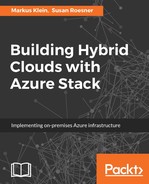This chapter is one of the most important ones in the whole book as it talks about real-world scenarios, how to design the solution, and the possibilities you have today. The chapters before were all about features and how to configure them.
As you have seen, even with version 1 of Azure Stack, there is a lot of work that could be done from a hybrid perspective and to connect services directly from and with Azure public cloud. Azure Stack is not a dedicated solution—it is Azure in your datacenter, not more but mostly less. Why less is quite simple to explain: Azure is being designed on thousands of servers, and Azure Stack is being designed with a small number of services that from a return on investment (ROI) perspective are worth running in your or your service provider's datacenter and not being consumed from public Azure.
So, there is nearly no chance to just think about Azure Stack (unless you are a service provider yourself) and not even think about Azure and how to connect these two worlds into one solution for yourself or your customer. There are some services with Azure Stack that even rely on Azure technologies, such as Azure Active Directory. If you are in a connected scenario, you just need Azure AD to set up Azure Stack.
From a developer's perspective, Azure Stack with additional PaaS services from Azure or even Azure Stack is the basis for work on cloud-native applications that are stateful and do not fail if a service switches from one server to another or even from one cloud to another.
If we think more globally, it is even possible to connect Azure Stack to a cloud offering from a different vendor (such as Amazon Web Services or Google) and even set up hybrid solutions, especially using third-party solutions such as Cloud Foundry and DC/OS or just containers. As some enterprise customers rely on a two-vendor cloud strategy, Azure Stack could be the in-between place to connect each other with a simple but smart way of reusing Azure technologies.
In the next chapter, we will have a look at two scenarios of hybrid cloud solution design and discuss their setup and design and why to choose them.
